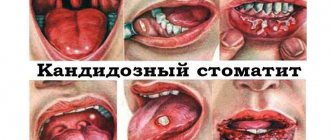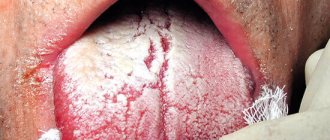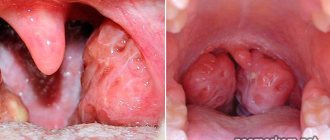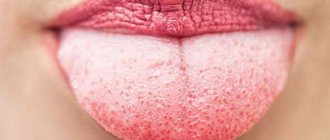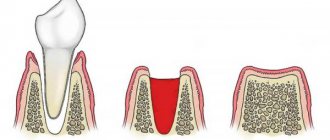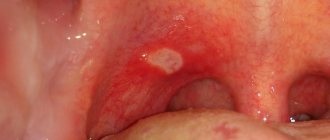In normal condition, the throat in young patients should be pink, without bubbles, plaque or other formations on the mucous membrane. But due to weakened immunity, children get sick too often, as a result of which one can observe a white coating on the child’s tonsils, indicating inflammation in the body. Such symptoms require consultation with a doctor and treatment.
Tonsils play an important role - they prevent the penetration and proliferation of bacteria and viruses, acting as a natural barrier. The child's body is still too weak to be resistant to disease. An infection that has gotten inside is easy to notice due to the changed condition of the tonsils.
Why does plaque occur?
Pus and light plaque are formed due to pathogenic microbes and viruses. The tonsils diligently perform their function, trying to save the entire body, thus “taking the blow upon themselves.” The tonsils consist of many channels and depressions where food debris, oral bacteria and infiltrated infections accumulate.
A mixed accumulation of substances becomes a favorable soil for the proliferation of viruses, fungi and microbes that disrupt the normal state of the mucous membrane. The result of the process becomes noticeable thanks to white stripes, plaque, ulcers - external manifestations depend on the neglect of the situation.
Even if the child’s overall condition is satisfactory, you should visit a doctor. Purulent formations indicate that the tonsils cannot cope with an infectious attack, which means that the virus can easily penetrate the bronchi and lungs.
Useful tips
- Problems with the tonsils and other organs of the respiratory system will become significantly less if the child breathes sufficiently humidified air. It is desirable that it in the apartment is not lower than 50%, but not higher than 70%. A special device for household use - an air humidifier - will allow you to create such conditions.
- Treatment of tonsils should not be carried out independently, without the advice of a doctor. Traditional methods can harm the child.
- If you find white plaque on your tonsils, you should not try to remove it yourself using improvised means. This can injure the child, cause bleeding, infection with additional microbes, and in the case of fungal plaque, lead to faster spread of colonies, which can cause serious complications, such as fungal sepsis.
- Immediately after the child’s temperature drops, you can begin to walk in the fresh air. For the respiratory system and for the process of restoration of lymphoid tissue after infection, it is very important that the child leads an active lifestyle. In addition, walking helps the immune system recover and strengthen faster.
For more information on what to do if you find white plaque on your child’s tonsils, see the following video.
Diseases
Changes in the tonsils are accompanied by increased body temperature. Such signs are observed in the following cases:
- An atypical form of sore throat - this disease is rarely characterized by high fever. The disease is caused by two bacteria living on the mucous membrane. Their name is fusiform rod and spirochete. Their formation and development usually occurs in cases where proper oral care is lacking, with advanced caries, as well as with reduced immunity. Bacteria gradually corrode the membrane of the tonsils, multiplying in ulcers.
- Chronic tonsillitis - patients with this diagnosis almost always have a white coating on the tonsils. Sometimes it may appear as streaks or spots. The temperature can be either high or normal.
- Stomatitis - in this case, white lumps spread over the entire surface of the oral cavity, including on the tonsils. Traditional treatment brings relief, and as the ulcers heal, they can become ulcer-like. Within a few days they decrease in size and fade away.
- Thrush is a disease caused by fungi; a cheesy coating is located on the tongue and tonsils. May be yellow. Usually, such unpleasant sensations are encountered by those who do not follow the rules of personal hygiene. Young children may not always be able to brush their teeth properly and thoroughly, so parents should monitor this closely. Thrush also often occurs due to the abuse of antibiotics.
- Pharyngitis and acute respiratory infections are diseases in which, in addition to plaque, a sore throat is felt.
- Cysts - similar formations on the tonsils are very similar to ulcers, but require completely different treatment.
- Leukoplakia - this pathology causes keratinization of the mucous membrane, ulcers and can be a harbinger of oncology.
- Burn - when the mucous membrane heals after injury, it acquires a white tint.
- Food residues - after consuming dairy products, traces similar to a white coating can sometimes be observed. They can be removed by regular rinsing.
- Diphtheria - in most cases with this disease, changes in the tonsils are observed. If left untreated, the disease can lead to serious consequences, including death. Therefore, if a child’s temperature is high, you cannot do without consulting a doctor.
Sore throat, white coating on tonsils
The main causes for such symptoms are acute respiratory viral infections, acute respiratory infections, sore throats, and similar diseases that affect the nasopharynx. In this case, there is an elevated temperature and breathing problems.
A sore throat with a white coating may also indicate the onset of diphtheria, but its cases are extremely rare thanks to modern vaccination. Separately, the presence of a whitish coating on the tonsils or their areas with physical tissue damage is distinguished.
Then pain is a natural reaction to the movement of the healing mucosa.
Diagnostics
The appearance of white plaque, blisters, ulcers and other pathological formations is characterized by other symptoms:
- enlarged lymph nodes in the neck;
- headache;
- discomfort or pain in the mouth;
- dry cough;
- increased body temperature;
- heavy breathing, shortness of breath;
- fever.
Depending on the disease, one of the above symptoms may occur. It is strictly forbidden to make a diagnosis on your own, as you can only harm the child. This can be done by the attending physician, an otolaryngologist, after a series of studies. Usually they do a general blood test and take a smear for flora.
If the doctor at the appointment established looseness of the tonsils, but did not find any other abnormalities, then you should not look for additional problems and accuse the doctor of incompetence. Often the tonsils become enlarged due to decreased immunity. Moreover, overgrown lymphoid tissues tend to atrophy. If there are no associated diseases and symptoms, the looseness of the tonsils and blisters may disappear over time. However, white plaque and ulcers require mandatory treatment in accordance with the doctor’s instructions.
Plaque on the tonsils in a child
White plaque on the throat in a child appears more often than in adults, due to the fact that children's immunity is weaker and more susceptible to infectious attacks. The transmission of infections in kindergartens and schools is more active, and diseases are more aggressive.
At the same time, a child can get the same diseases as adults, so timely diagnosis and diagnosis by a specialist is absolutely important, rather than home treatment with grandma’s remedies (they can only be used with the permission of the pediatrician).
We invite you to familiarize yourself with Methylene blue: instructions for use for children with stomatitis - how to properly use the blue solution
Symptoms without fever
Blisters, white plaque, loose and enlarged tonsils and lymph nodes - children often experience such symptoms, but they feel fine. There is no fever, no runny nose - many parents don’t even know that their kids are sick with something, because there are no complaints or suspicious behavior on their part. Is it worth panicking and taking some measures in this case? And why do such changes occur if the child is outwardly healthy?
Doctors answer this question unequivocally - first you need to conduct an examination. There may be viruses or fungi in the body that have caused the infection. If the tests are normal, then changes in the throat are most likely caused by the child’s frequent presence in a group. Looseness and blisters in this case are not pathological in nature, but are only a feature of lymphoid tissue. There is no need to remove or wash them, but you should pay attention to the prevention of viral diseases - increasing immunity, inhaling with saline or mineral water, visiting salt rooms, trips to the sea.
If the situation does not improve, the child is too sick, and at night he snores and has difficulty breathing, then doctors may recommend removal of the tonsils. At the same time, parents must understand that the body’s natural barrier will disappear along with them, which means it will be easier for infections and viruses to penetrate.
What symptoms may accompany the appearance of ulcers?
White plugs can appear in the throat for various reasons. Only a qualified specialist can determine which disease caused such characteristic symptoms after studying the results of bacterial culture from the throat and carrying out other diagnostic measures. Typically, the appearance of traffic jams is accompanied by the same clinical manifestations, regardless of the type of disease:
- Signs of intoxication of the body with metabolites of pathogenic microorganisms and a decrease in the level of immune defense. This may include weakness, impotence, headache, reluctance to eat, vomiting, diarrhea, high body temperature, aches in bones and joints, muscle pain, skin sensitivity.
- The mucous membrane of the throat is red, inflamed, swollen, with small hemorrhages.
- White rashes in the throat, tonsils and lymph nodes may be enlarged.
- The child has difficulty speaking and swallowing. The baby speaks in a whisper, his voice is hoarse or hoarse. Breastfed babies refuse to latch on to the breast, preferring an easier-to-suck bottle.
- The baby is capricious. White ulcers are very painful and prevent the child from sleeping.
- Mucus may appear on the back wall of the larynx and drain down. Mucus contains many pathogenic microorganisms, so its appearance stimulates the activation of the inflammatory process.
- The tonsils and mucous membrane of the throat may lose their smooth structure and become loose and porous.
- Congestion in the throat may be accompanied by swelling of the nasal mucosa and the appearance of snot. In this case, nasal breathing is greatly complicated.
- With purulent otitis media, pain in the ears and neck also appears.
- Indigestion, abdominal pain.
- Cough – non-productive dry or productive wet.
- Various skin lesions may appear - redness, swelling, rashes, itching, dryness and flaking of the skin.
We invite you to familiarize yourself with What is candidiasis in a child, methods of prevention and treatment
All these manifestations of the disease bring children a lot of unpleasant sensations, but congestion in the throat is truly dangerous. They destroy lymphoid tissues, causing the appearance of foci of destruction and tissue scarring. The tonsils cease to perform their barrier function and themselves become a source of infection for the body.
Also, the level of local and general immunity is significantly reduced, the child becomes defenseless against any pathogenic microorganisms and can easily catch another dangerous infection.
Therefore, if parents find white lumps in their child’s throat, they urgently need to diagnose the disease and begin treatment.
Important! If you find white lumps in your child’s throat (plugs in the lacunae of the tonsils), you need to start treatment immediately.
Treatment
The method of treatment is chosen by the doctor individually, depending on the disease:
- Sore throat that occurs without fever and chronic tonsillitis require treatment with drugs aimed at combating streptococcus - these are broad-spectrum antibiotics. In parallel with this, it is necessary to rinse the tonsils from plaque and plugs with pus. The procedure is performed in medical institutions. You can do without it, but the recovery process in this case will be delayed.
- Rinsing is an excellent remedy for plaque, purulent formations and inflammation, relieving pain and discomfort. The procedure can be carried out with soda and salt, or with antiseptic drugs (miramistin, furatsilin). If the child is still too small and does not know how to gargle, then the procedure can be replaced by irrigation with the same compounds. Rinsing should take at least 5 minutes, otherwise it will have no effect. It is better to irrigate the oral cavity 6-7 times a day, after which you should not eat food for 30-40 minutes.
- In case of thrush, plaque is removed with a soda solution, but antifungal drugs are more often prescribed. It is not easy for children to cope with thrush - a fragile immune system is not able to quickly overcome fungi, so serious systematic treatment is required and compliance with all doctor’s recommendations.
In addition to drug therapy and procedures, it is important to adhere to a number of rules in order to get rid of an unpleasant disease as soon as possible:
- give up solid and irritating foods, giving preference to soft cereals, jelly, lean broths, purees, etc.;
- Likewise, you should refrain from eating cold and hot food;
- do not apply warm compresses to the throat - heat promotes the growth of bacteria;
- Drinking plenty of fluids will help quickly remove the infection from the body and improve the condition of the tonsils.
How to remove plaque
Reliable ways to get rid of plaque on the throat are gargles and special sprays that can be purchased at the pharmacy.
Maximum effectiveness is achieved by washing the tonsils in the hospital with antibacterial solutions.
This way, a specialist can completely rinse the lacunae of the tonsils, remove purulent, cheesy plugs, and get to areas that are virtually impossible to treat at home.
Home rinses are carried out using a solution of soda, salt, furatsilin, infusions of medicinal herbs (chamomile, calendula, sage). The dosage and proportions should be agreed with your doctor. Sore throat, superficial plaque is well removed by sucking or chewing honey, lemon, garlic (you need to be careful with the last two, otherwise you can get a chemical burn to the mucous membrane).
Angina
With this disease, the white plaque is not continuous; most often it is a whitish or yellow fragmented plaque in the form of ulcers and plaques. These formations are especially noticeable against the background of bright reddened, swollen tonsils.
This symptom always occurs with a temperature, sometimes very high. In place of the white spots, pustules may appear a little later. The location of the plaque is the tonsils, sometimes the tongue is covered with a white dense layer.
You will learn how to recognize a sore throat in the next video.
